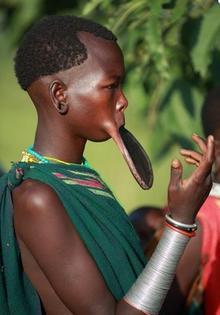
The lip plate, also known as a lip plug or lip disc, is a form of body modification. Increasingly large discs (usually circular, and made from clay or wood) are inserted into a pierced hole in either the upper or lower lip, or both, thereby stretching it. The term labret denotes all kinds of pierced-lip ornaments, including plates and plugs.Today, the custom is maintained by a few groups in Africa and Amazonia.


In Africa, a lower lip plate is usually combined with the excision of the two lower front teeth, sometimes all four. The initial piercing is done as an incision of the lower lip of 1 to 2 cm length, and a simple wooden peg is inserted. After the wound has healed, which usually takes between two and three weeks, the peg is replaced with a slightly bigger one. At a diameter of about 4 cm, the first lip plate made of clay is inserted. Every woman crafts her own plate and takes pride in including some ornamentation. The final diameter ranges from about 8 cm to over 20 cm.
Among the Sara people and Lobi of Chad, a plate is also inserted into the upper lip. Other tribes, such as the Makonde of Tanzania and Mozambique, used to wear a plate in the upper lip only. Many older sources reported that the plate's size was a sign of social or economical importance in some tribes. But, because of natural mechanical attributes of human skin, the plate's size may often depend on the stage of stretching of the lip and the wishes of the wearer.



A variety of materials were used in the manufacture of lip plugs, which included wood, ivory, clay, bone, shiny metal, shell and sometimes crystal. They could be found in round or trapezoid shapes of various sizes. There were carved rings, as well as simple balls fitted with a flat base which were inserted to the lower lip.
In South America among some Amazonian tribes, young males traditionally have their lips pierced and begin to wear plates when they enter the men's house and leave the world of women.Lip plates there are associated with oratory and singing. The largest plates are worn by the greatest orators and war chiefs, such as Chief Raoni of the Kayapo tribe, a well known environmental campaigner. In South America, lip plates are nearly always made from light wood.
In the Pacific Northwest of North America, among the Haida, Tsimshian, and Tlingit, lip plates are used by women to symbolize social maturity by indicating a girl's eligibility to be a wife. The installation of a girl's first plate was celebrated with a sumptuous feast.




This how the lip looks like on removal of the plates.
Tribes that are known for their traditional lip plates include:
- The Mursi and Surma (Suri) women of Ethiopia
- The Sara women of Chad (ceased wearing plates in the 1920s)
- The Makonde of Tanzania and Mozambique (ceased wearing plates several decades ago)
- The Suya men of Brazil (most no longer wear plates)
- The Botocudo of coastal Brazil (in previous centuries, both sexes wore plates)
- Aleut, Inuit and other indigenous peoples of northern Canada, Alaska and surrounding regions also wore large labrets and lip plates; these practices had mostly ceased by the twentieth century.
- Some tribes (Zo'e in Brazil, Nuba in Sudan, Lobi in west Africa), wear stretched-lip ornaments that are plug- or rod-shaped rather than plate-shaped.


Modern version

SOURCE: wikipedia.com
ezakwantu.com
BME.com
MAY GOD HELP US''
ReplyDelete